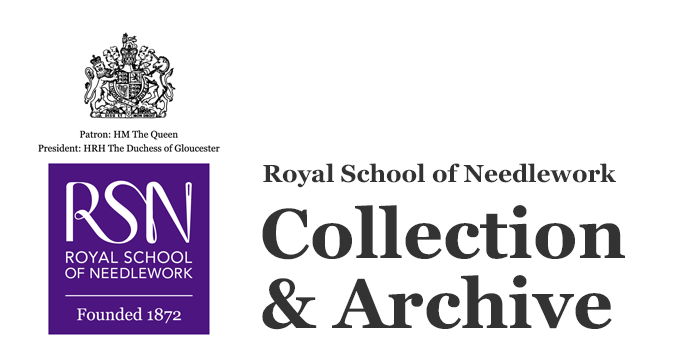Picture
Object name
Date made
Circa 1650-1675
Place made
Description
Embroidered picture of flowers, a vase, a castle, insects, and animals, entirely worked in coloured metal threads and dating to approximately the third quarter of the 17th century.
Content description
Embroidered picture in coloured metal threads dating to approximately the third quarter of the 17th century (1650-1675). It consists of a central vase of flowers and leaves worked in a variety of metalwork techniques including cutwork, chipping, couching, and S-ing in various patterns. At the top of the picture is an elaborate walled castle with a sun to the viewer's left and a moon and stars to the right. Below the castle is a pair of caterpillars. Recognisable imagery includes Tudor roses, irises, pansies, tulips, leaves (oak and otherwise), and acorns. Nearly all of the embroidery is worked in silk-wrapped purl.
Three motifs (a pair of rabbits in the middle left of the scene, a parrot in the upper right corner, and a squirrel in the lower right corner) are exceptions to this, worked in colourful silks instead of metal thread. These motifs are embroidered in satin stitch, stem stitch, and French knots. These motifs now sit below conservation netting.
There are several areas of wear that reveal the underdrawing. There is a butterfly toward the middle right that is no longer covered in embroidery, making the underdrawing visible. The purl has worn away in several spots, also providing glimpses of the underdrawing. The piece has been conserved at some point in the past, at which time netting was used to cover and protect the satin ground. Though the piece is dusty and heavily damaged, with its silk satin ground disintegrating around the embroidery, it remains a wonderful example of early modern girlhood embroidery.
While this type of work, with its almost exclusive use of silk-wrapped purl, often adorned the back of an embroidered casket (a table top box used to hold sewing supplies, writing supplies, precious goods, etc.), this piece does not appear to be designed for that purpose. It was very likely created by a well-off schoolgirl or girl in the home as part of a formal embroidery education. The central design, with a large and abundant vase of flowers, is typical of this period and was a favourite amongst embroiderers well into the 18th century.
Three motifs (a pair of rabbits in the middle left of the scene, a parrot in the upper right corner, and a squirrel in the lower right corner) are exceptions to this, worked in colourful silks instead of metal thread. These motifs are embroidered in satin stitch, stem stitch, and French knots. These motifs now sit below conservation netting.
There are several areas of wear that reveal the underdrawing. There is a butterfly toward the middle right that is no longer covered in embroidery, making the underdrawing visible. The purl has worn away in several spots, also providing glimpses of the underdrawing. The piece has been conserved at some point in the past, at which time netting was used to cover and protect the satin ground. Though the piece is dusty and heavily damaged, with its silk satin ground disintegrating around the embroidery, it remains a wonderful example of early modern girlhood embroidery.
While this type of work, with its almost exclusive use of silk-wrapped purl, often adorned the back of an embroidered casket (a table top box used to hold sewing supplies, writing supplies, precious goods, etc.), this piece does not appear to be designed for that purpose. It was very likely created by a well-off schoolgirl or girl in the home as part of a formal embroidery education. The central design, with a large and abundant vase of flowers, is typical of this period and was a favourite amongst embroiderers well into the 18th century.
Dimensions
width: 61cm
height: 52cm
height: 52cm
Materials
Stitches
Bricking 
Chipping
Cutwork purls over soft string
Flat cutwork (goldwork)
Gold twist application
Pearl purl application
S-ing (goldwork)
Turning metal thread couching
Satin stitch
Stem stitch
French knot

Chipping

Cutwork purls over soft string

Flat cutwork (goldwork)

Gold twist application

Pearl purl application

S-ing (goldwork)

Turning metal thread couching

Satin stitch

Stem stitch

French knot

Techniques
Motifs
Catalogue number
COL.76
Other numbers
RSN 92
© Royal School of Needlework
